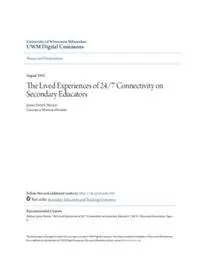
The Lived Experiences of 24/7 Connectivity on Secondary Educators PDF
Preview The Lived Experiences of 24/7 Connectivity on Secondary Educators
University of Wisconsin Milwaukee UWM Digital Commons Teses and Dissertations August 2012 Te Lived Experiences of 24/7 Connectivity on Secondary Educators James Patrick Heiden University of Wisconsin-Milwaukee Follow this and additional works at: htps://dc.uwm.edu/etd Part of the Secondary Education and Teaching Commons Recommended Citation Heiden, James Patrick, "Te Lived Experiences of 24/7 Connectivity on Secondary Educators" (2012).Teses and Dissertations. 9. htps://dc.uwm.edu/etd/9 Tis Dissertation is brought to you for free and open access by UWM Digital Commons. It has been accepted for inclusion in Teses and Dissertations by an authorized administrator of UWM Digital Commons. For more information, please contact THE LIVED EXPERIENCES OF 24/7 CONNECTIVITY ON SECONDARY EDUCATORS by James P. Heiden A Dissertation Submitted in Partial Fulfillment of the Requirements of the Degree Doctor of Philosophy In Urban Education at University of Wisconsin-Milwaukee August, 2012 ABSTRACT The Lived Experiences of 24/7 Connectivity on Secondary Educators By James P. Heiden University of Wisconsin-Milwaukee, 2012 Under the Supervision of Professor Gail Schneider Student access to the Internet has dramatically increased during the first decade of 2000. A recent study indicated that over 85% of US teens have regular access to a cell phone (Rideout et al., 2010). The cell phone coupled with an Internet plan has created the smart phone. This technology allows students to decide when and where they want to learn. This new connectedness has created a new phenomenon for classroom teachers; the ability to connect with their students in a 24/7 environment. This phenomenological study explored the lived experiences of five urban/suburban teachers in the Metro-Milwaukee area who routinely connect with kids 24/7 for educational purposes to examine what the impact of this phenomenon has on the teachers. The significance of this study was to shed light on the experiences of teachers who use technology to teach students when and where the students are ready to learn. There has been little or no research on this phenomenon given the newness of the technology. The teachers’ stories shed light on their experiences using a variety of software products to connect with students in an effort to increase student engagement and achievement. This study examined five high schools and is not generalizable to all high schools. The findings of this study revealed that teachers and students find a benefit to being able to connect with each other outside of the traditional classroom. Five themes, Connections; Firm Boundaries; Support – Administrative and Technological; Staff Development Needed; and The Evolving Classroom, and seventeen sub-themes were explored to determine implications for practice. Six implications for practice were identified: establishment of boundaries, time commitment needed, administrative and technological support, effective and meaningful staff development, curriculum ii development, and policy development. The study concludes with a list of recommendations for administrators and teachers who wish to explore opportunities to connect with students in a 24/7 learning environment. iii © Copyright by James P. Heiden, 2012 All Rights Reserved iv DEDICATION To my wife, Sue and my two sons, Kyle & Ryan. Your unwavering belief in me and the support you gave to me while I pursued my doctorate is immeasurable. Your countless times of pumping me up when I got discouraged were truly appreciated. This dissertation would not have happened without your love and support. v TABLE OF CONTENTS Abstract ........................................................................................................................... ii Dedication ....................................................................................................................... v Acknowledgements ....................................................................................................... xii List of Figures ..............................................................................................................xiii List of Tables ............................................................................................................... xiv Chapter 1: Introduction ................................................................................................... 1 Introduction of the Study............................................................................................. 1 Statement of the Problem ............................................................................................ 2 Significance of the Study ............................................................................................ 3 Contribution of Past Research ..................................................................................... 5 Limitations of Past Research ....................................................................................... 6 Limitations of the Study .............................................................................................. 7 Overview of the Study ................................................................................................. 7 Chapter 2: Literature Review .......................................................................................... 9 Review of the Literature .............................................................................................. 9 What Are Mobile Technologies? .............................................................................. 14 What is Mobile Learning? ......................................................................................... 16 vi Mobile Learning Implications for Students, Teachers & Curriculum Developers ... 18 Chapter 3: Methodology ............................................................................................... 24 Design and Methodology .......................................................................................... 24 Design of the Study ................................................................................................... 26 Research Questions ................................................................................................... 28 Definition of Terms/Variables .................................................................................. 29 Participants and Sample Selections ........................................................................... 31 Data Collection Procedures ....................................................................................... 33 Analysis of the Data .................................................................................................. 35 Triangulation & Quality Control ............................................................................... 36 Credibility.................................................................................................................. 37 Dependability ............................................................................................................ 38 Transferability ........................................................................................................... 38 Conformability .......................................................................................................... 39 Introduction of Research Participants ....................................................................... 40 #1 Oscar ................................................................................................................. 41 #2 Donald .............................................................................................................. 43 #3 Laurel ................................................................................................................ 45 vii #4 Loretta ............................................................................................................... 51 #5 June ................................................................................................................... 52 Summary ................................................................................................................... 54 Chapter 4: Findings and Results ................................................................................... 56 Introduction ............................................................................................................... 56 Textual and Structural Description ........................................................................... 58 Major Theme One: Connections ............................................................................... 59 Sub-theme: A Changing World for Students ......................................................... 60 Sub-Theme: The Digital Divide ............................................................................ 64 Sub-Theme: Flexibility for Both Students and Staff ............................................. 69 Sub-theme: Better Connections between Students and Staff ................................ 76 Major Theme Two: Firm Boundaries ........................................................................ 80 Sub-theme: Establishing Time Boundaries ........................................................... 80 Sub-Theme: Using Social Media to Connect with Students ................................. 86 Sub-Theme: Advice to Peers ................................................................................. 93 Sub-theme: Positive and Negative Aspects of Setting Boundaries ....................... 94 Major Theme Three: Support – Administrative and Technological ......................... 99 Sub-theme: Administrative Support ...................................................................... 99 viii Sub-theme: Technological Support ..................................................................... 105 Major Theme Four: Staff Development .................................................................. 113 Sub-theme: Current Staff Development Practices ............................................... 114 Sub-theme: Types of Staff Development Needed ............................................... 117 Sub-theme: Personal Professional Development ................................................. 123 Major Theme Five: The Evolving Classroom ......................................................... 126 Sub-theme: Technology – Smart Phones, iPads, etc. .......................................... 127 Sub-theme: Electronic Textbooks ....................................................................... 130 Sub-theme: Physical Setup .................................................................................. 133 Sub-theme: Flipped Instruction ........................................................................... 137 Summary ................................................................................................................. 141 Chapter 5: Discussion and Analysis ........................................................................... 143 Introduction ............................................................................................................. 143 Phenomenological Analysis of Experiences ........................................................... 144 Characteristics of Teachers Who Interact With Students in a 24/7 Learning Environment ........................................................................................................................ 148 Implications for Practice ......................................................................................... 157 The Need for Establishing Boundaries ................................................................ 157 ix
